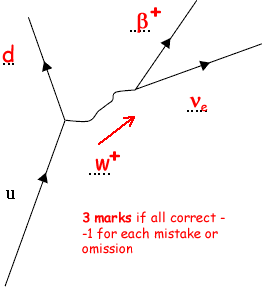Particle Physics Questions that involve Feynman Diagrams
Q3.  decays, forming a new nucleus, by releasing a
decays, forming a new nucleus, by releasing a  particle and one other particle which is difficult to detect.
particle and one other particle which is difficult to detect.
(a) Name the particle which is difficult to detect. (1 mark)
neutrino 
(b) Write down the proton number and the nucleon number of the new nucleus. (clearly indicate which is which!) (2 marks)
proton number = 10 
nucleon number = 22 
(c) Name the baryon and each of the leptons (clearly indicate which is a baryon and which is a lepton) formed as a result of this decay. (3 marks)
baryon = neutron 
lepton = positron 
lepton = (electron) neutrino 
(d) Give the quark structure for
(i) a neutron and udd 
(ii) a proton. uud 
(1 mark)
(e) Complete the following Feynman diagram so that it represents  decay.
decay.

(3 marks)
(Total 10 Marks)







